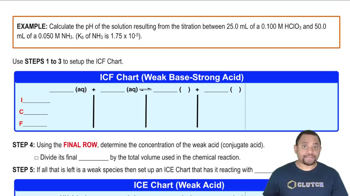Here are the essential concepts you must grasp in order to answer the question correctly.
Titration
Titration is a quantitative analytical technique used to determine the concentration of an unknown solution by reacting it with a solution of known concentration. In this case, the titration involves a weak acid being neutralized by a strong base (NaOH), which results in a change in pH that can be plotted to visualize the reaction's progress.
Recommended video:
Equivalence Point
The equivalence point in a titration is the stage at which the amount of titrant added is stoichiometrically equivalent to the amount of substance present in the sample solution. At this point, the reaction between the acid and base is complete, and the pH of the solution changes dramatically, often indicated by a steep slope in the titration curve.
Recommended video:
pH of the Equivalence Point
The pH at the equivalence point varies depending on the strength of the acid and base involved in the titration. For a weak acid titrated with a strong base, the pH at the equivalence point will be greater than 7 due to the formation of a weak conjugate base, which can hydrolyze in water, resulting in a basic solution.
Recommended video:
pH at the Equivalence Point Example





